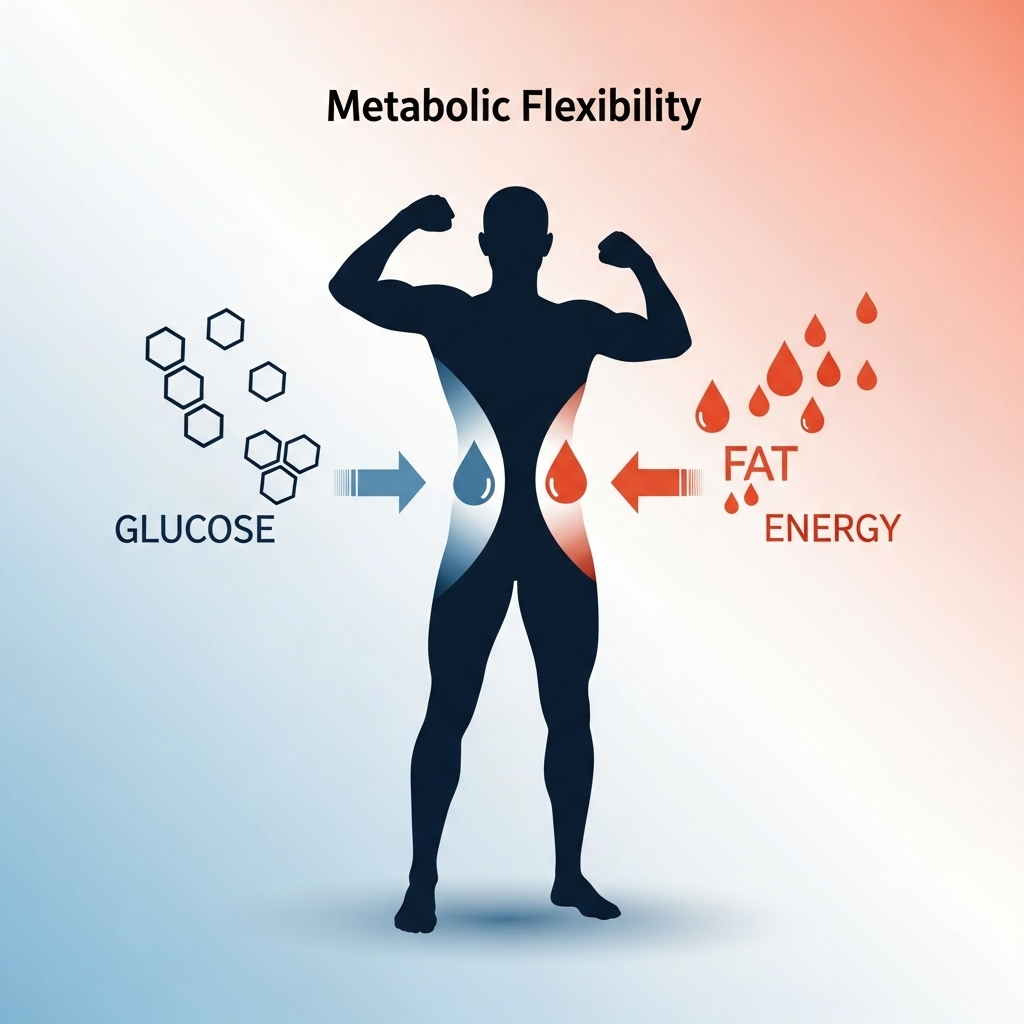In the world of metabolic health and diabetes management, few concepts have gained as much important attention in recent years as metabolic flexibility. As someone deeply passionate about optimizing health through evidence-based approaches, I've seen firsthand how this physiological capability can transform not just numbers on a lab report, but quality of life itself.
But what exactly is metabolic flexibility, and why should it matter to you? Let's dive into this fascinating aspect of human metabolism that might just be the missing piece in your health journey.

Understanding Metabolic Flexibility: The Body's Remarkable Adaptation System
At its core, metabolic flexibility describes your body's ability to efficiently switch between different fuel sources—primarily glucose (sugar) and fat—depending on what's available and what's needed. Think of it as your metabolism's gear-shifting capability.
When functioning optimally, a metabolically flexible body can:
- Burn glucose effectively after a meal
- Seamlessly transition to burning fat when glucose isn't readily available (like during fasting or sleep)
- Utilize the appropriate fuel for different activities (fat for low-intensity activities, glucose for high-intensity bursts)
However, many of us have inadvertently trained our bodies to become "metabolically inflexible" through modern dietary and lifestyle patterns. The consequences? A metabolism that stubbornly relies on glucose, struggles to access stored fat for energy, and experiences uncomfortable symptoms when blood sugar levels fluctuate.
Signs of metabolic inflexibility often include:
- Energy crashes between meals
- Intense hunger or cravings when meals are delayed
- Difficulty losing weight despite efforts
- Brain fog or irritability when hungry
- Poor performance during fasted exercise

It's important to distinguish metabolic flexibility from the broader concept of metabolic health. While related, metabolic health encompasses multiple parameters: blood glucose levels, insulin sensitivity, blood pressure, triglycerides, and HDL cholesterol levels. Metabolic flexibility is one crucial component of this broader picture—perhaps the dynamic aspect that reflects how well your metabolism adapts to changing conditions rather than just its baseline status.
The Life-Changing Benefits of Optimizing Your Metabolic Flexibility
The implications of improving metabolic flexibility extend far beyond abstract biochemical concepts. They translate into tangible, life-enhancing benefits:
Stable, Sustained Energy
When your body can easily tap into fat stores between meals, you escape the blood sugar roller coaster that leaves so many people experiencing mid-morning or afternoon energy crashes. Instead, energy levels remain remarkably stable throughout the day.
As one patient told me after improving her metabolic flexibility: "I used to plan my entire day around when and where I could eat. Now I can go hours without thinking about food and my energy never dips."
Enhanced Exercise Performance and Recovery
Athletes have long recognized the advantage of metabolic flexibility. Those who can efficiently burn fat have a nearly unlimited fuel source for endurance activities, saving precious glycogen reserves for when they're truly needed (like that final sprint).
Research shows metabolically flexible individuals can:
- Burn more fat at higher exercise intensities
- Preserve glycogen stores during prolonged activity
- Recover more efficiently between training sessions
Improved Insulin Sensitivity and Glucose Control
For those concerned about diabetes risk or managing existing diabetes, this benefit cannot be overstated. Metabolic flexibility directly correlates with insulin sensitivity—your cells' responsiveness to insulin.
When cells respond appropriately to insulin, less is needed to manage blood glucose. This creates a virtuous cycle: improved insulin sensitivity → better glucose handling → reduced inflammation → further improved insulin sensitivity.
Body Composition Optimization
Perhaps the most visibly apparent benefit for many is improved body composition. When your metabolism can readily access and utilize stored fat, maintaining healthy body fat levels becomes considerably easier.
This isn't just about aesthetics—it's about reducing metabolically active visceral fat (the dangerous fat around organs) and improving the ratio of lean mass to fat mass, which further enhances metabolic health.
Practical Strategies to Enhance Your Metabolic Flexibility
Moving from concept to application, here are evidence-based approaches to train your metabolism to become more flexible:
1. Strategic Carbohydrate Management
Contrary to some popular advice, becoming metabolically flexible doesn't require eliminating carbohydrates entirely. Instead, focus on:
- Quality: Choose complex, fiber-rich carbohydrates (vegetables, legumes, whole grains) over refined options
- Timing: Consider concentrating carbohydrates around periods of physical activity when glucose utilization is enhanced
- Context: Pair carbohydrates with protein, healthy fats, and fiber to moderate their blood glucose impact
A practical approach might involve gradually reducing refined carbohydrates while increasing healthy fats, which helps retrain your metabolism to utilize fat more efficiently.
2. Implement Strategic Fasting Windows
Time-restricted eating (TRE) or intermittent fasting provides excellent opportunities for your body to practice switching between fuel sources. Even modest fasting windows can yield significant benefits:
- Start with a 12-hour overnight fast (e.g., finish dinner by 7pm, eat breakfast no earlier than 7am)
- Gradually extend to 14-16 hours if comfortable
- Monitor your response—effective fasting should leave you feeling energized, not depleted
During fasting periods, your body depletes glucose stores and transitions to fat burning, essentially practicing the very metabolic flexibility you're aiming to enhance.

3. Incorporate Targeted Exercise Strategies
Exercise is a powerful tool for improving metabolic flexibility, particularly when strategically implemented:
- Zone 2 training: Moderate-intensity cardiovascular exercise (where you can still maintain a conversation) trains your fat-burning capacity
- Resistance training: Builds metabolically active muscle tissue and improves glucose disposal
- Strategic fasted training: Occasionally exercising before breakfast can enhance fat-burning adaptations
A balanced approach incorporating both endurance and strength training seems to offer the greatest benefits for metabolic flexibility.
4. Leverage Technology for Personalized Insights
Modern technology allows unprecedented visibility into your metabolic responses:
- Continuous glucose monitors (CGMs): Reveal your body's specific reactions to different foods, exercise, stress, and sleep
- Ketone testing: Can indicate when your body has successfully switched to fat-burning mode
- Heart rate variability (HRV): Reflects autonomic nervous system function, which influences metabolic processes
These tools provide objective feedback, helping you understand your personal metabolic patterns and refine your approach accordingly.
The Path Forward: Metabolic Flexibility as a Lifetime Pursuit
Enhancing metabolic flexibility isn't a quick fix but rather a gradual recalibration of your body's fundamental energy systems. Patience and consistency are essential—most people report noticeable improvements within 2-3 months of dedicated effort.
The beauty of this approach is its sustainability. Unlike extreme diets or punishing exercise regimens, improving metabolic flexibility involves working with your body's natural adaptations rather than fighting against them.
As you progress on this journey, you'll likely notice benefits extending beyond metabolism—improved mental clarity, better stress resilience, enhanced immune function, and a greater sense of control over your health and wellbeing.
Remember that metabolic flexibility exists on a spectrum, and perfect flexibility isn't the goal. Rather, we're aiming for improvement from wherever your starting point might be. Each step toward greater flexibility yields proportional benefits for your overall health.
For those concerned about diabetes risk or managing existing diabetes, few interventions offer as much potential for meaningful, lasting improvement as enhancing your metabolic flexibility—your body's fundamental ability to adapt to changing energy needs and fuel availability.
References:
Goodpaster BH, Sparks LM. Metabolic flexibility in health and disease. Cell Metabolism. 2017;25(5):1027-1036. doi:10.1016/j.cmet.2017.04.015
Smith RL, Soeters MR, Wüst RCI, Houtkooper RH. Metabolic flexibility as an adaptation to energy resources and requirements in health and disease. Endocrine Reviews. 2018;39(4):489-517. doi:10.1210/er.2017-00211






